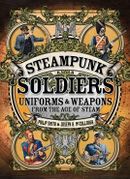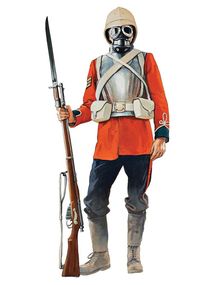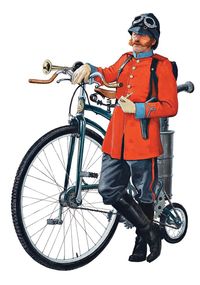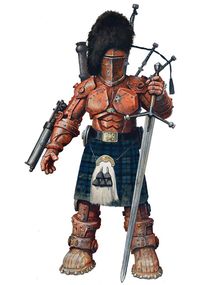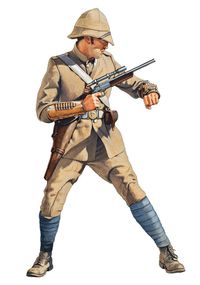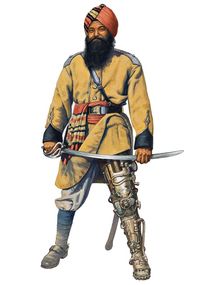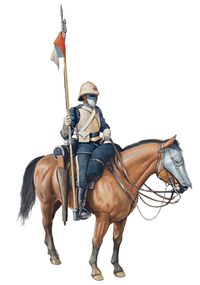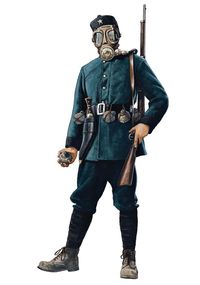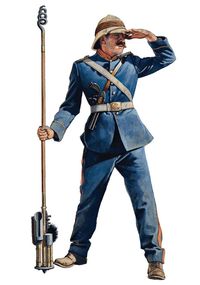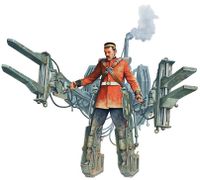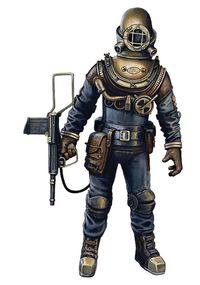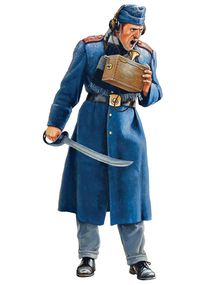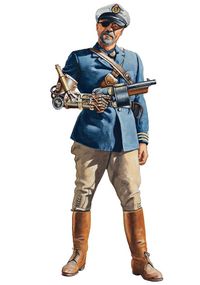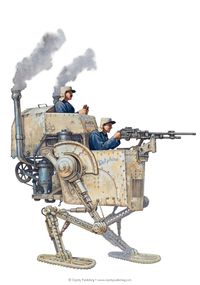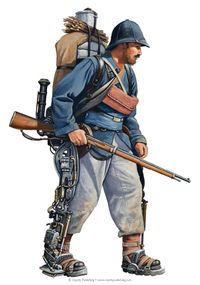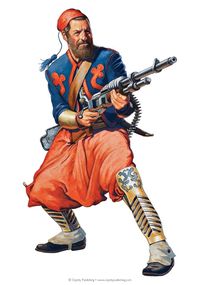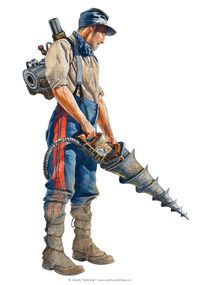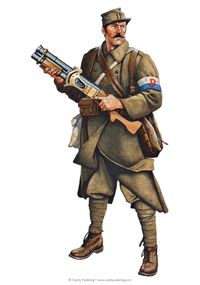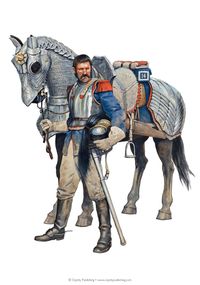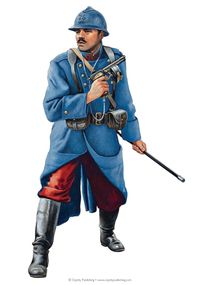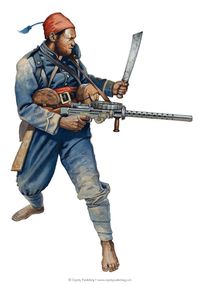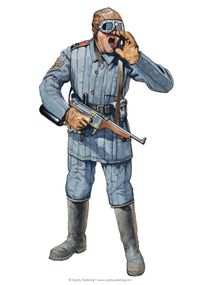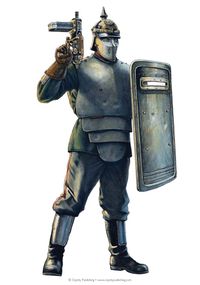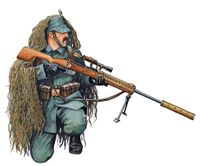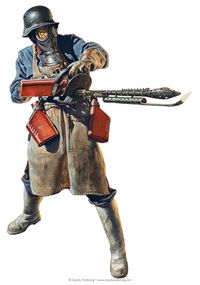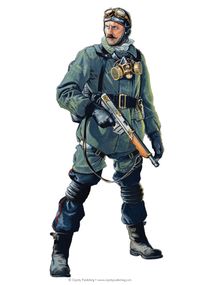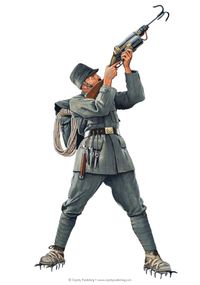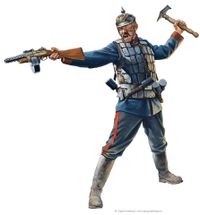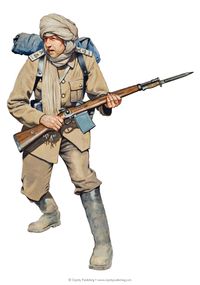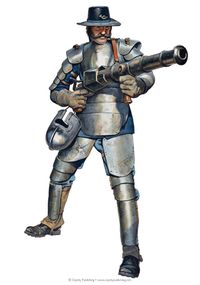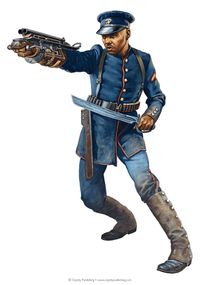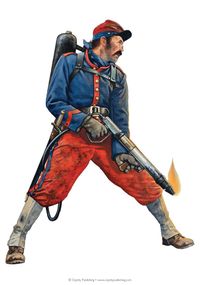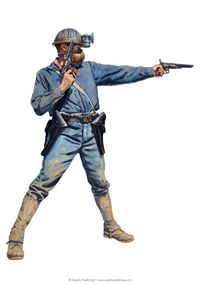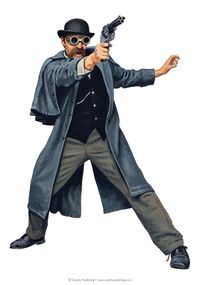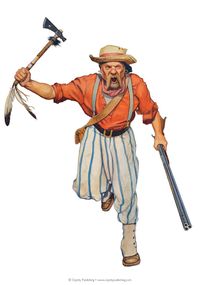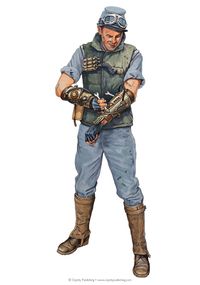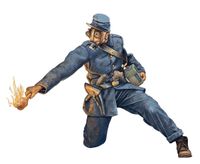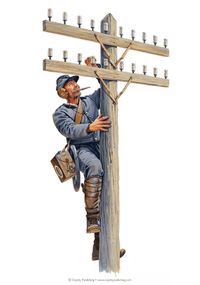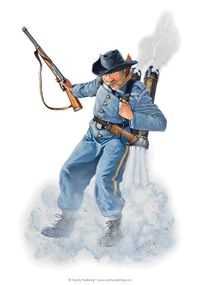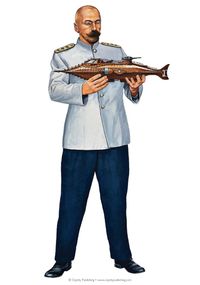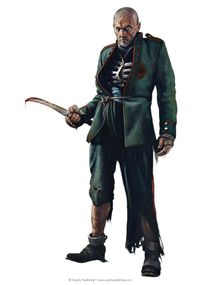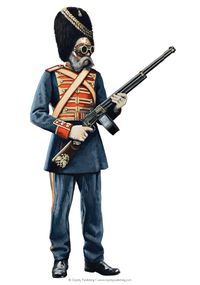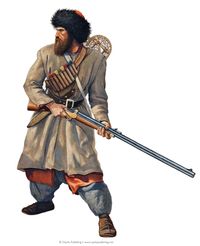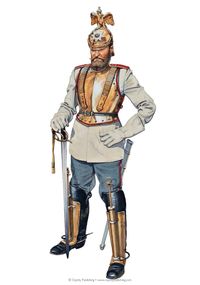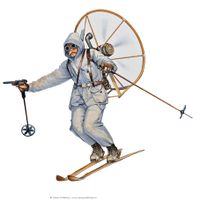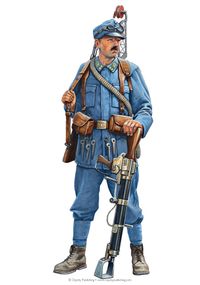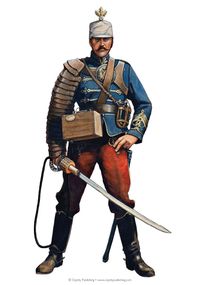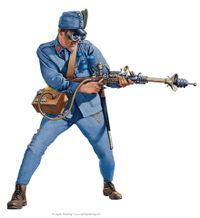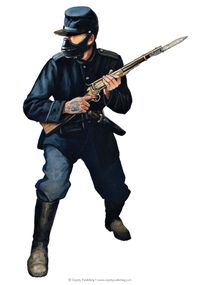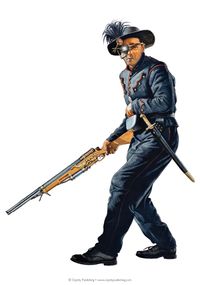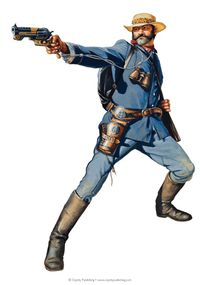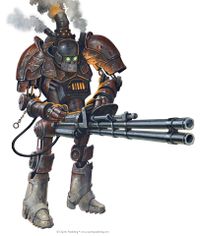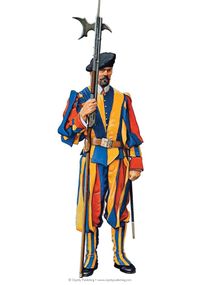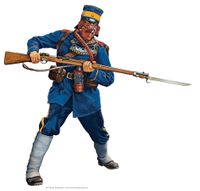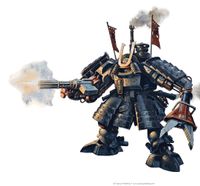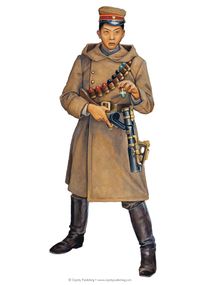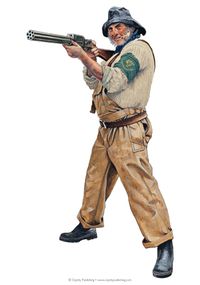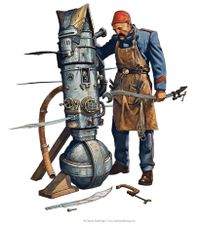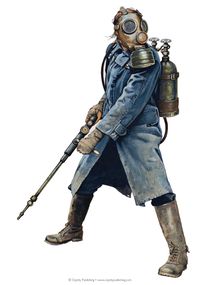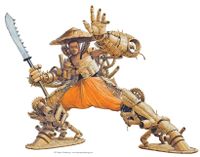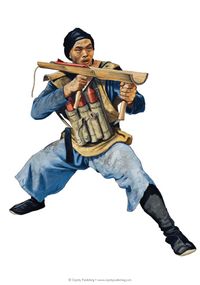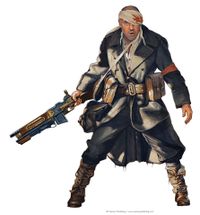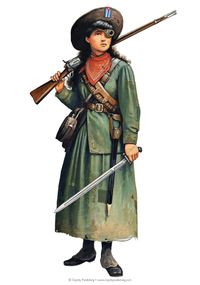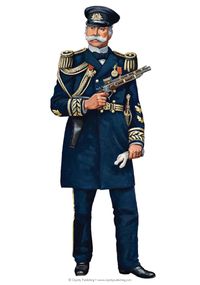Солдаты стимпанка
Материал из ВикиВоины
Steampunk Soldiers (рус. Солдаты стимпанка) — книга издательства Osprey Publishing, вышедшая в рамках серии Osprey Adventures в 2014 г. и посвященная альтернативной истории. Авторы книги — Филип Смит и Джозеф А. Маккалоу, иллюстрации выполнил Марк Стейси.
Книга представляет собой набор из 65 планшетов-иллюстраций различных воинов XIX века с кратким описанием. За основу были взяты реальные исторические воины и сюжеты (военная реформа Чайлдерса, восстание сипаев), однако к ним были добавлены элементы стимпанка — главным образом в плане вооружения и снаряжения. Качество иллюстраций не уступает другим изданиям Osprey Publishing, как и комментарии, которые написаны со знанием всех тонкостей военной истории XIX века (за исключением раздела о России, который содержит немало развесистой клюквы). Книга состоит из девяти разделов, каждый из которой посвящен определенной стране (Великобритания, Франция, Германия, США, Россия, Австро-Венгрия, Италия, Япония, последний девятый раздел посвящен всем остальным странам). Все представленные воины датируются 1880-ми - 1890-ми гг.
В 2016 г. вышло продолжение этой книги под названием "Steampunk Soldiers: The American frontier" (рус. Солдаты стимпанка: американское пограничье).
Список воинов[править]
Великобритания[править]
В июне 1886 г. лорд Челмсфорд (генерал Фредерик Тезигер) привел смешанные силы пехоты, кавалерии и инженеров в казармы в Портсмуте и быстро исчез. Официально лорд Челмсфорд и все войска, находящиеся под его командованием, были сочтены как "потерянные в море", но, как ни странно, нет никаких записей о том, что британские корабли пропадали в то время. На самом деле, нет ни одного свидетеля, который подтвердил бы, что видел, как войска грузятся на какие-либо корабли. Более тысячи британских солдат просто исчезли. В то время считалось, что войска направлялись в Африку, и их снаряжение соответствовало этому. Их блестящие стальные нагрудники обеспечивали хорошую защиту от примитивного местного оружия, а защитные очки и фильтрующие маски помогли бы справиться с африканской пылью.
За недолгое время, прошедшее с момента её основания в 1886 г., курьерская служба произвела огромное впечатление на общественное сознание. На самом деле, "Демонстрационные гонки" 1887 г. были настолько популярными и визуально впечатляющими, что королева Виктория приняла Службу как свою собственную. Однако не все в вооруженных силах настолько были поглощены службой. В то время как их велосипеды-пауки с паровым приводом идеально подходили для того, чтобы мчаться вверх и вниз по хорошим дорогам и тихой сельской местности Британии, они имели лишь минимальное применение на поле боя или во время военных действий. Кроме того, для отряда, который редко участвовал непосредственно в бою, они несли необычайно высокий уровень потерь: в их отчетах о тренировках часто появлялись сломанные руки, запястья и кости шеи. Все сотрудники Курьерской службы были вооружены лишь револьвером Уэбли, а ездили на "Woodhead Racer II" фирмы Рэли, который в полевых испытаниях набирает скорость 30 миль в час (48 км в час).
Из-за огромного скачка в дальности, точности и скорострельности новых типов огнестрельного оружия, появившегося во второй половине XIX века, некоторые эксперты начали считать, что дни настоящего рукопашного боя подходят к концу. В Шотландии, однако, военные инженеры упорно трудились, чтобы найти способы сохранить знаменитую традицию рукопашной атаки горцев, чтобы она была актуальна на современном поле боя. Для этого был разработан "Боевой доспех горца", работающий на котле Brunel Mk VIII "Super Burn", благодаря чему этот костюм был способен выдерживать почти восемь часов боя в полевых условиях без дозаправки. В бою его тактическая роль заключалась в том, чтобы как можно быстрее сблизиться с противником, а затем использовать его клеймор и увеличенную за счет паровой энергии силу, чтобы нанести как можно больше ущерба. Он также был оснащен установленным на руке скорострельным мини-"Максимом", который мог стрелять на ходу. Спорным решением стало то, что костюм также включал в себя встроенную автоматическую волынку, способную играть "Scotland the Brave" в непередаваемых тонах.
В рамках реформ 1881 г., проведенных военным министром Хью Чайлдерсом, 49-й принцессы Шарлотты Уэльской полк и 66-й Беркширский пехотный полк были объединены в новый Королевский Беркширский полк и получили казармы в Рединге. К сожалению, полк являлся лишь еще одним примером административного хаоса, вызванного реформами Чайлдерса, в результате которых половина британской армии использовала традиционную полковую структуру, а другая половина была организована через "бригадные округа". Королевский Беркширский полк в 1880-х гг. находился в Южной Африке. Хотя в то время Британия официально не вела военные действия, большинство офицеров в Беркширском полку предпочитали убирать знаки различий с униформы из-за нападений снайперов и других попыток убийства. Показанный офицер вооружен однозарядным снайперским пистолетом Bournbrook "Eagle-Eye", а на левой руке у него стрелковый наруч охотника со встроенным патронташем.
Основанный в 1803 г. как иррегулярный кавалерийский полк для Ост-Индской компании, полк Всадников Скиннера являлся одним из старейших полков Британской индийской армии, сражавшихся в Первой и Второй афганских войнах и Первой и Второй сикхских войнах. Это было также одно из туземных подразделений, которые оставались верными Британской империи во время мятежа 1857 г. В отличие от многих подразделений индийской армии, во Всадниках Скиннера служили как британские, так и туземные офицеры. Здесь изображен один из таких туземных офицеров, одетый в традиционный жёлтый китель полка и красочный пояс. Укладка кушака, которая также повторяется в тюрбане, или дастаре, отражает полную мужества и чести историю подразделения. Необычно, что офицер также носит раннюю модель парового протеза. Из-за их высокой стоимости на субконтиненте встречались даже более старые модели протезов. Этот, кажется, получил специальную модификацию, вероятно, чтобы она позволила владельцу лучше держаться в седле, сидя на лошади.
Во второй половине XIX века 17-й полк в полном составе не ступал на британскую землю почти 20 лет, будучи размещен как в Южной Африке, так и в Индии. Поскольку полк провел так много времени в мятежных районах, часто сражаясь лоб в лоб с плохо вооруженными местными жителями, он значительно изменил свой стандартный боевой костюм, включив в него более тяжелую броню для защиты от холодного и маломощного огнестрельного оружия. Особого внимания заслуживает пробковый шлем со встроенной маской для лица и тяжелый кожаный нагрудник, покрытый тканью. Пика оснащена детонирующим наконечником, который может быть взорван с помощью спускового механизма. Хотя нет никаких сомнений в серьезности ран, которые может нанести это оружие, многие в армии называют такие пики чрезмерно убийственными. Также возле седла у солдата прикреплен карабин, вероятно, это кавалерийский карабин Snider-Enfield.
Поскольку британские интересы в Тибете и Китае возросли во второй половине XIX века, правительство было вынуждено искать новых агентов для ведения разведки на этих территориях. Неудивительно, что оно стало чаще обращаться к солдатам различных гуркхских полков. Хотя британские официальные лица это отрицали, общеизвестно, что гуркхи проскальзывали через Гималаи в Тибет поодиночке и небольшими группами в течение многих лет. На задании эти агенты были оснащены большим количеством специального снаряжения, которое было разработано для их функций в качестве иррегулярных разведчиков. Самое известное из того, что они использовали — набор различных газовых гранат, от дымовых до ядовитого облака. У них даже были такие, которые действовали как дефолиант, хотя их военное применение неясно. Агент, изображенный здесь, также снабжен игольчатым ружьем Remington и британским противогазом азиатской модели. Конечно, это все в дополнение к знаменитому ножу гуркхов, кукри.
4-й полк имеет давнюю историю испытаний нового и экспериментального снаряжения, поэтому неудивительно, что он стал первым подразделением, оснащенным "самоходными орудиями". Первоначально эти орудия были обозначены как "артиллерия без лошадей", но как бы они ни назывались, нет никаких сомнений в том, что эти мобильные пушки значительно помогли армии с точки зрения сохранения лошадей и живой силы. Правда, они были подвержены поломкам и с трудом действовали на пересеченной или грязной местности, но именно поэтому каждая батарея продолжала держать одну конную команду под рукой. Наиболее известны примеры использования 4-м полком их оружия во время осады и захвата Триполи (1877 г.) и битвы за Столовую гору (1881 г.), за что они получили похвалы от своих командиров и боевые награды от правительства. Этот артиллерист каким-то образом приобрел четырехствольный "хаудах", больше ассоциирующийся с защитой от тигров, чем с использованием на войне. Он также держит банник нового образца с регулируемой головкой для обслуживания артиллерии.
Девиз Корпуса Королевских инженеров — Ubique (рус. Везде) — и он резюмирует историю этого почтенного подразделения. Хотя корпус не получал боевых наград, как другие полки, Королевские инженеры участвовали в каждой кампании, в которой участвовала британская армия, и часто оказывались критическим фактором, который играл решающую роль в исходе сражения. Сержант Королевских инженеров, показанный на иллюстрации, готов к тяжелой работе благодаря инженерному костюму Брунеля. Названный в честь (хотя и не разработанный им) выдающегося инженера, этот костюм с паровым приводом давал его владельцу/оператору повышенную прочность и выносливость и мог быть оснащен различными инструментами для инженерных работ. В этой конфигурации костюм оснащен стандартными, но универсальными клешнями или клещами.
Большая часть британской военной стратегии была сосредоточена на силе и универсальности Королевского флота и его способности проецировать мощь Империи по всему миру. В то время как мастерство Королевских морских пехотинцев никогда не подвергалось сомнению, некоторые фракции в Адмиралтействе полагали, что они не используют весь свой потенциал в качестве войск, одинаково комфортно сражающихся на суше и на море, и вложили немалые деньги и усилия в развитие различных методов и оборудования для усиления этой роли. Следовательно, Королевские морские пехотинцы теперь стоят впереди всех в областях амфибийных операций, речных операций и морского десантирования. Эта иллюстрация показывает бойца морского десантного отряда. Обученные глубоководным погружениям в дополнение к участию в обычных боевых операциях, эти войска были оснащены кислородными баллонами и пневматическими винтовками, стреляющими стальными дротиками, и обычно использовались для скрытых военно-морских десантов. В ходе индонезийской кампании (1890 г.) Королевские морские пехотинцы, несущие на себе несколько баллонов с кислородом, благополучно переправились с удерживаемого британцами Луука на оккупированный немцами остров Пеленг в ходе операции, которая стала известна как "Влажный марш".
В отличие от своих коллег в германском флоте, Zeppelintruppen, королевские морские пехотинцы, которые составляют отряды службы безопасности дирижаблей Королевского флота, не представляли элиту своего полка и не были особенно хорошо оснащены для этой роли. Действительно, перевод в такой отряд, как правило, рассматривалось как наказание, и в его рядах собралась пестрая коллекция дебоширов, пьяниц, злостных нарушителей устава и других смутьянов. На этом примере Королевского морпеха, служащего на HMA Leodegrance, мы ясно видим ограничения штатного снаряжения — этот человек повязал гражданский шарф в попытке согреться. Поскольку опасность огнестрельного оружия на борту дирижабля очевидна, отряды службы безопасности дирижабля обычно вооружались только абордажными саблями, и лишь несколько винтовок хранилось в надежном оружейном шкафчике для использования в чрезвычайных ситуациях. Морской пехотинец также оснащен портативной телефонной установкой, которая, будучи подключенной к соответствующей станции на судне, позволяла ему напрямую связываться с капитанским мостиком.
Гордость британских вооруженных сил, Королевский флот в XIX веке правил морями и участвовал в боях так часто, что его офицеры — почти поголовно — были закаленными в боях ветеранами. Командор Бомон с эсминца HMS Halifax участвовал в обоих сражениях в Аденском заливе (1886 и 1887 гг.) и в битве у Суматры (1890 г.), и по слухам отдал приказ открыть огонь в ходе бомбардировки Кейптауна (1873 г.). Именно у Суматры Halifax был поражен японской торпедой, спровоцировавшей взрыв, который стоил командору Бомону его правой руки, поскольку её заменили паровым протезом, который только усиливает эффект от его внушающего страх внешнего вида. В дополнение к потере правого глаза в ходе абордажного боя с приватиром Конфедерации в начале его карьеры, его травма неизбежно породила прозвище Старый Нельсон, которым его наградила команда. Командор имеет при себе дробовик с барабанным магазином "Nock Decksweeper", который является излюбленным оружием экипажей Королевского флота для абордажных схваток.
Франция[править]
This Renard-class reconnaissance walker, ‘Delphine’, belongs to the 2nd Battalion, 2nd Regiment of the French Foreign Legion. It is a lightly armoured, fast-moving vehicle that embodies the Legion’s role as a rapid reaction force within the French military. Its broad, flat feet, while offering good balance and weight distribution essential in the North African deserts for which it was designed, place the machine at a distinct disadvantage should the terrain become excessively rocky or otherwise obstructed – hence the legionnaires’ nickname of ‘Pied Plat’ (Flatfoot). As it is intended solely as a scout vehicle, the Renard is armed with a single Saint-Etienne machine gun. Despite its design shortcomings, the Renard has seen service in all the Legion’s conflicts since its introduction in 1875. Now a somewhat obsolete model, many Renard-class walkers have been sold to various nations, principally (and somewhat controversially) to all those involved in the Second War of the Triple Alliance (1880–84). Still, it continues to find a home with the Legion units stationed in Africa, where its speed and range make it an invaluable weapon in their arsenal.
March or die!’ The unofficial motto of the French Foreign Legion is engrained so deeply in the Legion’s mentality that it might as well be the official one. The Legion’s reputation for endurance and focus sees it employed as a rapid reaction force, deploying at a moment’s notice to whatever war zone demands it. Legionnaires have always taken pride in their ability to ‘march all night and fight all day’, and recent technological developments have only served to enhance this. The legionnaire of the 1st Battalion, 3rd Regiment seen in this study is equipped with Peugeot-built steam-powered exoskeleton legs, which greatly increase the wearer’s strength and endurance. He carries a full pack and the weighty Lebel M1886 rifle. He also wears the covered pith helmet that marks him as a member of one of the Asian garrisons. While the popular image of the Legion is of the white kepis of the North African units, it was in Indochina that the Legion really made its name. The arrival of Legion forces in 1875 turned the tide of the war, and legionnaires were at the forefront of the counter-attack that pushed back the Chinese armies and crossed into China itself the following year.
Originally raised from amongst the Berber inhabitants of France’s Algerian territories, the Zouaves are now an all-French unit, though they still maintain the distinctive North African style of dress. Indeed, their dress is the only aspect of the original Zouave formation to have survived to the present day. Whereas once they fulfilled a light infantry role, in recent years they have been used increasingly as shock troops, thrown to the front of assaults or charged with holding the line against seemingly impossible odds. The Zouaves have long held a tradition for unflinching bravery in defence and unstoppable ferocity in attack, and recent conflicts have offered them many opportunities to add to their legend. While they may lack the technology of their German counterparts, the Sturmtruppen, they are still amongst the better-equipped units in the French Army, as this study shows. This assault machine-gunner of the 3rd Zouaves carries a Hotchkiss 75, one of the most sturdy machine guns to be produced by that venerable firm. Worn in addition to the traditional Zouave dress is what appears to be adapted cavalry armour in the form of breastplate, greaves, and forearm guards
Having pioneered the use of the sapper with Vauban in the 17th century, the French Army still leads the way in the field of military engineering. While British and German military engineers may be better-equipped and sport more advanced engineering technology, the French engineer regiments have had ample opportunities to hone their craft, and show an imagination and flair for the unexpected that comes from hard experience of having to work miracles with the tools they have. Examples of this versatility include diverting the Black River (1884) and breaking the stalemate in the siege of the supposedly impenetrable Austrian castle of Hochosterwitz (1891) by mining the rock upon which it stood and bringing down most of the south face. Here we see a sergeant of the 6th Engineer Regiment stripped and in the midst of some typically heavy labour. He carries a one-man, steam-powered drill of uncertain origin – certainly it has been much used in its time.
The rather grim-sounding units of the French Army known as ‘Les Perdus’ (the Lost) are formed from the remnants of units that have suffered such heavy casualties that they are no longer an effective force on their own. Such is the need for men in certain theatres that commanding officers have, rather than sending survivors away from the front lines to recuperate, thrown together the remnants from several units and sent them back into the fight. The formation of such units was one of the major causes of the Army Mutinies of 1889, and the practice has since declined. Here we see a grenadier, formerly of the 11th Infantry Regiment, in service with a unit of the Lost, as indicated by the distinctive armband. He carries a Saint-Etienne M1885 slide-action grenade launcher, which can hold three rounds in the tubular magazine and one in the chamber, allowing for multiple shots before reloading. Although it offers considerable firepower, the M1885 has been criticized by its operators for being prone to jamming in wet conditions.
With so many nations reducing the size of their cavalries in the face of the changing nature of warfare, it perhaps comes as something of a surprise to learn that the French cavalry has actually grown since the 1870s. In truth, most of that increase is down to the expansion of the dragoon and mounted infantry regiments, but it does highlight the curiously French attachment to the mounted soldier. Adjustments to suit this age of rapid-firing weaponry have been made, of course, as can be seen in this study of a man of the 14th Cuirassiers and his mount. The rider is equipped in the same way as a cuirassier of the Napoleonic Wars, but closer inspection shows that his armour is made of modern bullet-resistant alloys, and his carbine will be an automatic model. The horse’s trappings are a throwback to the medieval warhorse, displaying the type of armour that was made obsolete by the introduction of the musket – again, however, it is highly advanced. With man and mount better protected against shot and shell, perhaps the age of the cavalry charge has not yet passed.
This study depicts a captain of the 26th Infantry, a regiment chiefly raised from the commune of Sarlat-la-Canéda in the Dordogne. The regiment has adopted a nickname based on the crest of their hometown – ‘Les Salamandres’ (the Salamanders) – and, like the myths surrounding that creature, it has come through the fire time and again. Regardless of its posting, the 26th seems to possess an uncanny ability to find itself in the thick of any action – so much so that it has become viewed throughout the Army as a whole as the unluckiest regiment in the French military. Even when posted to one of the Channel garrisons, the 26th found itself the target in an artillery training exercise. Despite this record, the men display the staunch resilience of the French soldier – le poilu – accepting their lot with true Gallic indifference. The captain seen here is armed with a Steyr M1887 repeating pistol, either privately purchased or taken as a trophy during the clashes with Austrian forces in the early 1890s. Given that the 26th was not involved in that particular campaign, the former explanation seems the most likely.
The Senegalese Tirailleurs, despite their name, are recruited from all of France’s West and Central African colonies, and form the bulk of ‘La Coloniale’ – the French colonial forces. While the majority serve within their home nations as garrisons, it is becoming increasingly common for African troops to be sent to European war zones as reinforcements. In this study we see a tirailleur of the 4th Regiment, dressed in the typical manner. Despite serving in Europe, he eschews the issued boots, preferring the barefoot approach seen most often amongst the African garrisons. He is armed with a Lewis Automatic Rifle and the fearsome Senegalese coupe-coupe knife. The American-designed Lewis is something of an oddity within the French arsenal, due to its non-domestic origins. This model, however, is the French-pattern Lewis, built under licence by Hotchkiss. The coupe-coupe, much like the Lewis, is a foreign arm that has been adopted by the French military. Originally a traditional Senegalese blade, the effectiveness of the weapon-cum-tool is such that mass-produced versions are being supplied to all French forces serving overseas.
Германия[править]
Formed from the most exceptional officers and NCOs of the Seebataillon (Marines), the Zeppelintruppen are the Imperial German Navy’s elite troops. Five battalions exist today, based throughout the German territories, with their main headquarters in the Wetterstein range where the altitude and temperatures offer the best possible acclimatization training. Their role is to provide security for all zeppelins of the German armed forces, whether on the ground or in the air. While serving on an active zeppelin, the Zeppelintruppen wear a many-layered and quilted uniform for warmth, and carry Dreyse air rifles, as seen in this study of a man of the 2nd Battalion. Hard experience has taught the Imperial German Navy the perils of flames and sparks on board a zeppelin, so the Dreyse air rifles were introduced to minimize such risks. A pump-operated reservoir stores compressed air, which can be released to fire lead slugs. While the risk of a slug sparking against a metal strut still exists, the absence of ignition makes the Dreyse a far safer option than a conventional firearm
Undoubtedly the most feared of the German armed forces are the Sturmtruppen (stormtroopers), who are to be found at the forefront of every assault, approaching methodically and swiftly, leaving no resistance behind them. Each man of a Sturmabteilung (assault detachment) is an imposing physical specimen, further hardened by the aggressive training through which they are put. Rumours abound of psychological conditioning that leaves them as emotionless killers, but these seem farfetched and are more likely the product of propaganda than of actual evidence. Still, the German Army has played up to these rumours, which augment the reputations earned through the Sturmtruppen’s combat operations – the crushing of the Danzig Riots (Spring 1879) and the capture of Fort Beauregard (February 1882) being two prominent examples. Indeed, until the 1884 Ruhr offensive, the Sturmtruppen were considered invincible by their enemies. This member of a Saxon Sturmabteilung is equipped for public order duties, as noted by the uncovered Pickelhaube helmet. He wears the typical armour of the Sturmtruppen and carries a riot shield and a heavily modified Mauser assault pistol, fitted with a box magazine to reduce the frequency of reloading
Drawn from amongst the already-talented marksmen of the Jäger regiments, the German Army’s Sniper Corps are sharpshooters par excellence. Even more frightening than their skill is the number in which they can take the field – while most nations command very few sniper units, the Imperial Sniper School in Thuringia produces graduates at an alarming rate. Their numbers are frightening, but perhaps not surprising – German marksmen, especially those from Thuringia, dominate international shooting events, in much the same way that the Spanish maintain a stranglehold on the fencing competitions. In this study, we see a sniper of the 2nd Jäger Regiment wearing a camouflaged ghillie suit over his typical field uniform. Although this uniform limits their camouflage somewhat, it is an essential compromise considering how often such troops operate behind enemy lines where, if caught out of uniform, they would face charges of espionage. The Jäger snipers receive the finest precision rifles the German arms industry can produce, such as the Krupp–Browning 1892 ‘Mjolnir’ seen here, and the value of the Imperial contract is immense, so the competition is fierce
Though the secret of the Greek Fire that devastated the foes of Byzantium was lost, modern technology has provided suitable replacements. A terrifying weapon in the arsenals of many armies, the flamethrower was first developed by the German Army, and it is still amongst those ranks that the Flammenwerfer sees most use. Originally designed for a twoman team, with one man to operate the weapon and another to carry the heavy fuel tanks, recent research has introduced more lightweight equipment and more efficient fuels, making a one-man flamethrower viable. In this study, we see a flamethrower operator of the 15th Prussian Infantry, prepared for an imminent attack. In addition to the flamethrower and its fuel, he is equipped with a gas mask and a Stahlhelm, itself a recent introduction to the Germany Army. Flammenwerfers are commonly used in assault roles, clearing trenches, bunkers, and other fortifications with alarming ease. Needless to say, their operators are not beloved of their enemies, and will rarely be shown quarter.
The 1st Fallschirmjäger Regiment, nicknamed ‘die Fledermäuse’ (the Bats), holds the distinction of being the first air-deployed unit in history, with its first deployment coming during the Morocco offensive in 1880. With its powerful zeppelin fleet, the Imperial German Navy commands the skies, and the ability to drop troops from high-altitude zeppelins into the heart of a combat zone is an evident extension of this dominance. Such deployments are still relatively rare, although increasingly common, with most Fallschirmjäger seeing combat as regular infantry. The Fallschirmjäger regiments, especially the much-lauded 1st Regiment, have an exceptional esprit de corps, bordering on arrogance, and are as hated by their fellows in the infantry and, especially, the Seebataillon (with whom they vie for the Navy’s support and funding), as they are adored by the German press and the Imperial Admiralty. This paratrooper of die Fledermäuse is shown ready for a combat jump, wearing an insulated grey smock over his uniform, and armed with a Mauser 9mm automatic carbine.
Much like the French Chasseurs Alpins or Italy’s Alpini, the Jägers recruited into the German Army’s Alpenbataillon units are experienced mountaineers and marksmen before they even begin the intense training regime that is designed to identify only the strongest candidates. The rejection rate of candidates is some 80 per cent, and thus the men of the Alpenbataillon are considered a highly elite force. Despite their elite reputation, the most famous operation involving these units was the disastrous siege of Hochosterwitz in 1891, when French forces destroyed the south side of the mountain upon which the castle sat, bringing the fortifications down upon the heads of the Austrian garrison and their ‘advisors’ from the 2nd Alpenbataillon. With the shame of this defeat on their records, these mountain troops are highly motivated, especially when faced with French opponents, and often volunteer for the most risky missions. The Jäger of the 8th Alpenbataillon seen in this study is equipped for a mountain ascent, with a grappling hook launcher replacing his usual armament.
While the Sturmtruppen are the first choice for conducting assault operations, they are not always available to a commander, who must instead make do with what forces he has at his disposal. In this study we see a man of the 52nd Prussian Infantry who has been seconded to an assault pioneer detachment in preparation for a trench raid or similar mission. He is heavily armed with a Bergman MP81 automatic carbine, several grenades, and a vicious-looking trench axe. Unlike the Sturmtruppen, who have modern bullet-resistant armour, this infantryman has been forced to devise his own armour – a crude, home-made armoured jerkin. Some regiments select the members of an assault pioneer detachment solely from volunteers, others draw names from a hat – the 52nd Prussians simply work down an alphabetical list of the men. Regardless of how they are picked, assault pioneer detachments are called upon for similar duties, raiding enemy lines for reconnaissance, sabotage, and intelligence-gathering purposes.
Like the celebrated French Foreign Legion, Germany’s Seebataillon troops often find themselves thrust into the role of a rapid intervention force and posted to whatever colonial outpost is in need of reinforcement. In this study we see a private of the 3rd Seebataillon in North Africa. While he wears the typical Seebataillon uniform, he has adopted Tuareg headwear – the Tagelmust – which is not only a practical item of clothing for the desert, but also allows him very rapidly to blend into the crowd with the addition of the local robes that can be seen tied to the top of his backpack. The presence of such clothing marks this man out as a military advisor to one of the Tuareg tribes fighting against French colonial rule. He is armed with a Mauser G81, further emphasizing his role as a military advisor. While the G81 is no longer the principal rifle of the German military, thousands have been smuggled into the French and British African colonies in support of native risings and as gifts for pro-German chieftains who might be convinced to rebel.
США[править]
Despite the name, the heavy plate armour worn by the soldiers of the Iron Brigade is mostly composed of steel and ceramics. While it is unlikely to stop a direct hit from a modern highpowered rifle, it will completely halt ricochets and deflect glancing shots, and it offers a high degree of protection from shrapnel. It also makes these soldiers a fearsome force in hand-to-hand combat. The armour’s weight, however, severely limits the brigade’s use as a mobile force. For that reason, the brigade is based in Annapolis where it can quickly deploy to protect Washington, DC, should the Confederates (or anyone else) attempt to attack the capital. This defensive role is why many of the soldiers are equipped with the one-pounder ‘Hand Cannon’. Regulations state that soldiers in armour are required to wear their helmets at all times but, when not under fire, it is common for soldiers in the brigade to wear the famous, and much more comfortable, black hat.
Over the last decade, there has been a huge increase in the number of attacks upon the shipping of the United States. Although Confederate privateers account for most of these raids, Central American pirates have also played a major role. In response, the United States Marine Corps has nearly doubled in size in the last five years, and a large number of these new marines are actually serving on ships in a piratefighting capacity. Depicted here is a Marine rifleman currently serving on the battleship USS Andrew Johnson. He is equipped with an arm-mounted, compensated-recoil Winchester double-barrelled shotgun. While this gun is often painful to fire (even with the reduced recoil) and has a tendency to singe the skin even through the leather guards, it has the advantage of leaving the hands free: an important consideration during boarding actions. All marines serving on board warships are also issued with a ‘Pittsburg knife’, the nickname given to the modern version of the boarding cutlass, named for the city of its manufacture
The colourful and deadly ‘Fire Zouaves’ are one of the oldest volunteer regiments in the Union Army. Originally composed of soldiers drawn from New York City’s volunteer firefighters, the unit fought with distinction at the battle of First Bull Run (1861) where it took heavy casualties covering the Union retreat. After the battle, the unit was placed on guard duty around Washington, DC. It was during this time of relative inactivity that the former firefighters started experimenting with the first versions of their famous ‘dragon guns’. Although several men were killed during the early tests, the Union Army approved of the project and development continued. The unit finally returned to the field in time for the battle of Lynchburg (1867), where their guns proved too hot for the Confederates to handle. Today, the Fire Zouaves are rarely fielded as a unit. Instead, small detachments are seconded to other units in a support role.
The United States’ ‘Lucky 13th’ Engineer Battalion was formed in 1878 in response to the large fortifications projects undertaken by the Confederacy in that decade. Drawing its recruits largely from the mining towns of Pennsylvania, and equipped with several Mk II ‘Boremaster’ subterranean ironclad troop carriers, the battalion is trained specifically for strike and hold missions against fixed enemy fortifications. So far, the battalion has only ever been called upon to fulfil this mission once, during the 1884 ‘Wyoming Mutiny’. The soldier seen here is a private in the battalion, and would ride to battle inside one of the Boremasters. As such, he carries as standard issue a pair of sturdy Savage–North fast-fire pistols. He also has a traditional miner’s helmet with a carbide lamp and a reusable ‘clearair’ breather mask
When the Pinkertons became the official bodyguard of the President of the United States in 1868, they had already been performing the task for several years. Under their protection no president has been killed, or even wounded, despite numerous assassination attempts. (There have been at least seven well-documented cases). There are approximately 20 agents, working in shifts, assigned to the presidential bodyguard at any one time, although more can quickly be called in if needed. Generally, such bodyguards serve one presidential term, at the end of which they either retire or are assigned to other duties. The Pinkertons have no official uniform, but nearly all wear the grey longcoats and bowler hats that have become their trademark. Agents are generally allowed to purchase their own sidearm, and this one is armed with a rare, triple-barrelled 18-shot, 6.35-calibre Pistola con Caricato, manufactured in Italy. This agent also wears ‘starlight’ googles for night duty
The Louisiana Tigers is a unique organization within the Confederate Army. It is the only infantry unit that does not have any numerical designation, and the only unit that does not accept conscripts. Furthermore, it is the only unit that actively recruits its members from foreign countries. In many ways, the Tigers have become the Confederate version of the French Foreign Legion, accepting any volunteer who meets the physical requirements, regardless of background. Enlistment is for ten years, at the end of which the soldier is given citizenship in the Confederates States of America and a payment of 40 acres of land and a mule. The soldier depicted here is a classic example of the fearsome, piratical appearance adopted by many of the Tigers. The Tigers are allowed to use whatever weapons they prefer. This man is armed with a Remington triple-barrelled shotgun and a tomahawk, suggesting that he is usually employed in an assault role
Unlike the massive land dreadnoughts employed by Germany, the Confederate land ironclads are much smaller vehicles, usually containing a crew of between four and eight men and carrying only a single piece of heavy ordinance. This is partly due to the Confederacy’s lack of steel works and natural resources, but is also a function of the broken, heavily wooded terrain that still covers most of the border regions between the Union and the Confederacy. Fighting inside a land ironclad is hot, tiring, and dangerous work. While the regiment receives most of its soldiers from conscription assignments, there are a few volunteers who see the lumbering land ships as the warfare of the future. These volunteers are often assigned as drivers, such as the soldier depicted here. He wears a ‘Beauregard’-pattern flak jacket, designed to protect against flying rivets and other fragments inside the vehicle. It includes a compressed oxygen supply accessed by the tube on his chest. This driver has also obtained a pair of Swiss-made compact engineering tool kits that are worn on his forearms
The 3rd Mississippi Infantry Regiment was raised in 1861, with its first real action coming the next year during the Steele’s Bayou campaign. It was in those swampy forests that the regiment first employed the tactics for which it is now famous. As the Union gunboats travelled down the river, the Mississippians blocked their way with felled trees. They then placed large bales of pitch-soaked cotton on both river banks, set them on fire, and fanned the flames and the poisonous smoke towards their prey. In the 30 years since those original ambushes, the regiment has continued to refine its tactics and equipment. It has developed several different types of burning bales, which produce a variety of effects, including one that produces a highly acidic cloud. It has also created its own form of gas mask to protect its soldiers from their own deadly vapours. This plate depicts one of the regiment’s designated ‘firelighters’, who are given the dangerous task of actually igniting the deadly bales
While wireless communication is slowly becoming increasingly commonplace around the world, the vast majority of information in America is still sent by telegraph along the countless miles of telegraph line. Maintaining this network is difficult at the best of times, but with raiders from across the border sneaking over to cut or misdirect lines, it can sometimes seem impossible. This plate depicts one of those raiders, a private in the Confederate Army Signal Corps. His main job is to slip over the border and patch into the telegraph lines, either to spy on messages being sent or to send false information of his own. Note the top-of-the-line, portable Marconi telegraph transceiver dangling by his side. Soldiers in the Signal Corps always wear a uniform and rarely carry weapons. If caught, they are expected to surrender immediately. This happens so frequently on both sides that an efficient exchange system has been established specifically for signalmen
The idea of aero-cavalry, individual soldiers equipped with some kind of ‘flying pack’, has been around for at least 20 years. The Americans seem especially taken with the idea, and the Union and the Confederacy have both worked hard on the technology. So far, neither has really succeeded. Despite this, both armies contain aero-cavalry units. The soldiers in these units are currently equipped with ‘jump packs’. These dangerous devices use a huge build-up of steam pressure to launch the trooper off the ground in a high arc. A smaller blast of steam is then used to (hopefully) control the descent. Aero-cavalry is a good example of how the rush of technology has outrun current military strategy. To date, no aero-cavalry unit has ever been deployed in battle, and it is not completely clear what battlefield role it would fulfil. Still, it does not appear that the idea of a flying soldier is going to go away
Россия[править]
Admiral Zinovy Petrovich Rozhestvensky is arguably the world’s greatest thinker and tactician in the field of undersea warfare. Known affectionately as ‘Mad Dog’ to the men who serve under him, Rozhestvensky famously captained the Peter the Great, Russia’s first operational nautilus, during the battle of Hong Kong (1886). Thanks largely to that success, the Tsar named Rozhestvensky as the commander of the ever-growing Russian undersea fleet. It is unknown exactly how many undersea ships the Russian fleet currently contains. The fact that estimates range from as few as four to as many as 25 shows just how effective the Russians have been at keeping it secret. I would like to extend my personal thanks to the admiral for agreeing to a short meeting and allowing me to prepare this quick painting of him standing in his service uniform, and holding a model of the Peter the Great.
Russia first unleashed the soldiers of its new convict battalions during the siege of Plevna (1877), where thousands of former felons and political prisoners swept over the Ottoman positions and captured the town. For many years, the other European powers debated how Russia managed to instil such fighting spirit in its prisoners. Eventually, a few convict soldiers were captured and revealed the truth. Before battle, each member of the battalion is injected with a slow-acting poison. With the antidote carried by the convict battalion’s handlers behind the front lines, the soldiers have a simple choice – fight and stand a chance of survival or die a slow, agonizing death. The convict battalions have no official uniforms, nor are they officially armed. Instead they are equipped with whatever they can loot from the field, often from dead soldiers. The only real identifying features of the convict battalions are the shackles on their necks and ankles, and their shaved heads, as seen here. Interestingly, the convict battalions have no officers. Instead they are led by officers temporarily assigned from other units, often as punishment.
Formed in 1753 by Empress Elizabeth I, the 1st Regiment of Grenadiers of the Guard is one of the most fabled units in the whole of the Russian army. The regiment has fought in every major Russian conflict since its formation, and its list of battle honours is too long to mention. Most recently it fought with distinction during the War of Polish Division (1882–83), where its last-minute arrival at the battle of Lomza (1883) turned the tide and clinched victory for Russia. The regiment draws its recruits from soldiers in other units who have served out their term of enlistment, and service with the regiment is for a minimum of eight years, although most grenadiers tend to serve for life. The regiment is currently armed with the Americandesigned but Russian-manufactured Pitcher dual-barrelled semi-automatic rifle. The distinctive eye-mask worn by the grenadiers is officially simply part of the uniform, with no specific purpose, though many soldiers modify it to contain corrective or even enhancing eyewear.
Russia is currently the only nation to include vivandières in their regular army (France, Spain, and the United States having abandoned the practice several decades ago). Traditionally, these women provided water and wine to soldiers in the field and to the wounded. Although the Russian vivandières continue this tradition, they have now taken on a ‘medical’ role as well. No-one (outside of Russia) really knows what is contained in the strange flasks carried by the Russian vivandières, but there are numerous stories from both the Russo-Turkish War (1877–78) and the Mongolian Border War (1881) of badly wounded Russian soldiers rising to fight again after receiving an injection. However, few of these injected soldiers appear to have survived past the end of the battles. Currently, these women are somewhat protected on the battlefield by their non-combatant status, but there are many in the military community who are questioning this designation.
Few people really believe the rumours that the medveds of the Ursine Guard are really enhanced by a chemical cocktail containing bear’s blood, but it is hard to look upon these gigantic warriors and think of them as completely human. Each of these soldiers stands a minimum of seven feet in height and some appear to be nearly eight feet tall. Their shoulders are broad and their arms are long and extremely muscular. This tends to make them look slightly disproportionate and top heavy. The medveds do not fight as a unit. Instead, individuals or small groups are assigned specific tasks. The Tsar always keeps four on hand as part of his private bodyguard, as do many other high-ranking officials and military personnel. It is believed that a large number serve as independent border guards, roaming the vast wilderness of the Russian frontier. In battle, the medveds eschew firearms. Instead, they rely on close-combat weapons, the most common being the Turkish yatagan sword, the mace, and the fighting claw. Many are known to take scalps as prizes.
Only the most hardy individuals make their home in the vast, frozen waste called Siberia. Used to a life of loneliness and individual freedom, these men do not make good soldiers, at least not regular soldiers. But Russia does not let any potential military asset go to waste, so it has found a role for even these ill-disciplined men. Whenever the Russian Army goes on campaign, it is always accompanied by a small group of Siberian riflemen. Trained from birth as hunters and marksmen, Siberians make excellent irregulars. Employed as scouts, they move out ahead or on the flanks of the army, gathering intelligence and surveying the terrain. For this role, they are equipped with a special type of rifle, known affectionately as ‘the poison gun’. In actuality, the gun fires specialized darts filled with a powerful tranquilizer, perfect for taking prisoners for interrogation.
Thanks to Alexander Kirillovich’s famous poem, which has now been translated into nearly every language in Europe, the 1st Belarusian Lancers is probably the most famous cavalry unit in the world today. Although it was not the only unit to take part in the great charge that broke the British ‘Red Line’ at the second battle of Balaclava (1871), its name apparently fitted the metre of Kirillovich’s verse, and thus it has received most of the credit. Regardless, the unit is certainly one of the finest and most elite cavalry formations in Europe, and when the soldiers are dressed in their gleaming gold helmets, breastplates and greaves, they certainly look the part. Their leg greaves are unique in that they include a pair of built-in spur-syringes that can be employed by the soldier in the heat of battle. It is not known what is contained in these syringes, but their use temporarily increases both the speed and power of the lancers’ mounts.
Although technically a part of Russia, Finland is allowed to maintain its own armed forces, at least for the moment. As part of this ‘understanding’, Finland is charged with maintaining a constant patrol along the lengthy and mostly uninhabited border with Sweden. This task mainly falls on the shoulders of the frontier scouts. The frontier scout depicted here is equipped with the Russiandeveloped aeroski propulsion unit. In field tests, soldiers wearing this rig have achieved speeds upwards of 40 miles per hour, although only over long, flat expanses. Along with his rifle (covered on his back), the soldier is armed with a pair of Russian Luger ski poles. Although these guns are difficult to aim, they ensure that a speeding aeroskier is still capable of defending himself. As an added bonus, the ski poles serve as extended magazines for the pistols
Австро-Венгрия[править]
The Austro-Hungarian army maintains several specialized mountain warfare units, but k.k. Landwehr Infantry Regiment No. 4 is undoubtedly the most famous. Equipped with Alpinausrüstung (‘cablebacks’) the soldiers of this unit can literally glide into battle across deep gorges or down mountainsides. This tactic has proved extremely effective for launching surprise attacks, as was demonstrated during the Liechtenstein Incident (1882) and the Swiss Border Dispute (1885). This plate depicts a korporal in the unit. Along with his cableback and his M95 Mannlicher Repetierstutzen carbine, this soldier also carries a first-generation Krupp Felshakengewehr (piton gun). This hand-cranked, spring-loaded piton gun can fire a heavy piton up to 200 yards while trailing heavy slide cable. Using these guns, the soldiers are able to create their so-called ‘highways in the sky’.
Although the advent of steam walkers and self-propelled vehicles has lessened the need for traditional horse-mounted cavalry in Europe, a few of these older units have actually found new life in the modern era thanks to new weapons research. The Austro-Hungarian Husarenregiment No. 13 is a good example of this, as all of its troopers have been armed with the M99 Elektrischesäbel, or as it is more commonly known in English, the ‘Tesla-sabre’. Controlled by a small trigger hidden in the hilt of the sword, the Tesla-sabre is able to deliver a powerful electrical charge, easily capable of killing a man or even a horse. When used against a vehicle, it has been known to stun or even kill multiple crewmen. The heavy batteries worn by the troopers are only capable of providing a few seconds’ worth of charge, but that is enough to make these horsemen some of the most feared warriors on the modern battlefield
As part of the massive reforms of the Austro-Hungarian Army that have taken place over the last few years, nearly every infantry unit has been equipped with at least a couple of the feared Blitzgewehr, more commonly known in English-speaking countries as the ‘Tesla-gun’ or ‘lightning gun’. Each of these guns is served by a two-man team: the gunner who actually carries and fires the weapon, and the so-called ‘mule’ who has the unenviable job of carrying the extra batteries. Since each battery is only capable of a few seconds of sustained fire, mules are encouraged to carry as many batteries as physically possible. The soldier seen here comes from one of the newly organized Croatian regiments. The blue lanyard on his left shoulder indicates his training with the Blitzgewehr. Although the dark goggles are not standard issue, they are very common among the lightning gunners.
The Kingdom of Serbia has been under Austro-Hungarian control since the Congress of Berlin in 1878. While King Milan I of Serbia presents the relationship as an ‘alliance’, most Serbians view it as an occupation and have resisted it by any means available. In the last five years, a new army of ‘freedom fighters’ has arisen. Its members call themselves sablasts, which translates as ‘ghosts’ or ‘spectres’. Unlike most rebels, these soldiers are well equipped, wear uniforms, and seem to have an established rank structure. The sablasts almost always attack at night, hitting an Austro-Hungarian armoury or barracks and then fading away with the coming light. This depiction is actually based on various eye-witness reports. All agree that the sablasts wear a black version of the typical Serbian infantry uniform, with the addition of a dark face mask. Although their weapons vary, the most popular seems to be the American Colt ‘Quick-Load’ revolving carbine, a good weapon for close-range firefights, especially with the fold-out bayonet
Италия[править]
The Italian Marines were traditionally made up of marksmen and sharpshooters from the ranks of the Navy and maintain that tradition today, adding to their natural skill all the advantages of modern optics technology. Unlike most other nations, whose snipers and marksmen employ scopes mounted on the tops of their rifles, the Fanteria Real Marina equips its men with headgear that incorporates a staggering number of lenses that may be swung into or out of the line of sight as desired, allowing for an extremely precise aim. Although the sharpshooter illustrated in this study carries a bayonet at his hip, note that his rifle, a Lebel Sportif, does not. This privately purchased rifle will be the personal weapon of this marine, and attests to the policy of the Fanteria Real Marina that its marksmen be allowed to acquire whatever weapon best suits them, and be reimbursed by the Navy. Interestingly, the Italian government’s chief issue with this policy is neither the complexity of ammunition resupply nor the cost of purchasing such high-end firearms – merely that very few men opt for Italian-made rifles!
The Ufficio di Esplorazione (Office of Exploration) was established in 1869 by King Victor Emmanuel II with the intent of forging a colonial empire to rival those of the more established European powers. Its agents are sent out across the globe as explorers, diplomats, and conquerors all rolled into one, with the task of investigating possibilities for Italian conquest and colonization. With such a vague and challenging mandate, few within the Italian military see recruitment by the Office as a solid career prospect, and so it recruits its agents from across Europe – younger sons of noble families seeking adventure, professional soldiers of fortune, exiles, retired military officers unwilling or unable to escape the soldiering life, and other kinds of ne’er-do-wells. The Italian Army nominally oversees the Office’s activities, and awards all its agents with an honorary rank in an Italian regiment. This study shows an exploring officer and demonstrates the ad hoc nature of their uniform and equipment. He wears the uniform of the 27th Light Cavalry (Vicenza), but accompanies it with a privately acquired sun hat and large-bore Smith & Wesson revolver.
Named for the Italian hero Giuseppe Garibaldi, the Garibaldino automaton is the greatest success story of Italy’s Ufficio di Esplorazione. A damaged prototype of this unknown class of construct was discovered in 1880 in a deserted village outside Ankara by an Ufficio-sponsored expedition and smuggled back to Italy. Since then, the design, which has never been seen amongst the ranks of the Ottoman Automated Janissary Corps, has been tinkered with and modified by Italy’s military engineers. It is more heavily armoured than is commonly seen amongst its Ottoman cousins, no doubt due to the significantly reduced numbers available to Italian forces. The example shown here is armed with a twin-barrelled dynamite gun, a tool well suited to the basic level of command with which the Garibaldino may be programmed – ‘assault’, ‘defend’, and so on. Italian reverse engineering has yet to develop the subtlety and complexity of Ottoman automaton programming.
Since their founding in 1506, the members of the Pontifical Swiss Guard have become famous for their mission to defend the Pope against all enemies. Along with the soldiers of the Papal Zouaves, Palatine Guard, and Noble Guard, they also act as the army of the Vatican City. Technically, all members of the Swiss Guard are mercenaries, since they are all Swiss-born but fighting in the army of a foreign power, but they are rarely viewed that way. All members are required to be single, speak perfect Italian, and, of course, practicing Catholics. The Swiss Guard has undergone numerous uniform changes in the last hundred years. This halberdier (the lowest rank in the Guard) is wearing the current design, which attempts to combine their colourful Renaissance past with a more modern feel. The same can be said about the Guard’s preferred weapon, the 12-gauge, slide-action halberd-shotgun (manufactured in Italy under licence from Winchester)
Япония[править]
The Kemuri no Oni is one of the Imperial Japanese Army’s many dedicated assault troop formations. The name means ‘Smoke Demons’, and sums up both the unit’s fearsome reputation and its unusual equipment. As can be seen in this study of a Kemuri no Oni trooper from the 3rd Yokohama Infantry Regiment, a small brazier is worn on the hip, connected to a leering face mask. Into this brazier is packed a compound containing a variety of chemicals which, when set alight, produces a smoke that is then inhaled by the soldier. While under the influence of these chemicals, the Kemuri no Oni warriors are exceptionally aggressive, and also demonstrate an ability to ignore wounds that would halt any other man. Although they are equipped with rifles, and are sometimes used in a conventional infantry role, it is as assault troops that the Kemuri no Oni are most commonly deployed. This focus can be seen in their use of the bayonet – it is permanently fixed to the rifle, and they do not carry a bayonet sheath, unlike their regular infantry fellows.
As Japan developed into a modern industrial power, it traded heavily with a number of nations, acquiring expertise, advisors, and, most importantly, technology. Instead of just using what was purchased, however, Japanese scientists and engineers stripped apart every piece of hardware, identifying exactly how it worked, before initiating production of domestically manufactured copies, much to the distress of patent holders across the globe. In several cases, they even succeeded in refining designs to make them more effective than the originals. Consequently, it is quite common to see familiar machines in the arsenal of the Japanese military. This study, for example, shows one of the Daimyo-class armoured infantry suits from the 3rd Yokohama Infantry Regiment, which is, allowing for the aesthetic remodelling of the Japanese designers, practically identical to the German Kaiser-class suits. It maintains the Kaiser’s proven steam claw/ machine gun configuration. The most recent evolution of the Daimyo is the Shogun-class suit, which offers an improvement in speed and range with no significant reduction in armour or firepower. No doubt the German Army (not to mention the designers at Krupp–Browning, Vickers, and countless other firms) would love to get their hands on one
Although best known for its assault troops, the Imperial Japanese Army is a modern force, easily the rival of anything the Great Powers of Europe or America can muster. In this study we see a captain of the veteran 11th Koga Grenadiers, dressed in the M1893 khaki winter field uniform and equipped with an Arisaka grenade launcher. The 11th Koga Grenadiers have seen action in most of the major Japanese campaigns of recent times, from the defence of Okinawa (1875) and the invasion of China (1876) to the brutal island-hopping campaign in Indonesia against British, German, and local guerrilla forces (1890). The Indonesian campaign made the reputation of the 11th Koga Grenadiers as a specialist jungle warfare unit, and they will no doubt find themselves on the front lines once more if the long-running skirmishes in Cambodia between pro-Japan and pro-France militias continue to escalate.
Другие страны[править]
Although the various Fenian armies that have launched raids into Canada have never achieved much, with local garrisons on the border proving ample counter to the threat, far more successful have been the Fenian pirates – self-professed privateers – operating on the Great Lakes. Styled along military lines, with units operating in clearly defined territories, and well equipped with steam launches and even small armoured gunboats, these irregular forces have proven an enduring threat to shipping and industry in the region. With relations between Britain and the United States still tense, the privateers find American ports to be all-too-convenient refuges between raids. This bosun of the 3rd Huron Privateers wears common civilian attire with a green armband to proclaim his allegiance. He is armed with a Union Navy-issue Burnside revolving carbine, which only serves to further fuel the rumours that the Fenian cause is receiving more than just sympathy from the Washington government.
The Mechanical Engineers of the Ottoman Army are amongst its finest troops, trained by German instructors and equipped with as much of the most up-to-date technology as possible. The field in which the Mechanical Engineers excel is the construction, maintenance, and operation of the Automated Janissary Corps. These marvels of military engineering take many forms, from the bladed Dervish class (seen here) to the flamethrower-armed Naffatun class, and all ranks are encouraged to develop new designs and systems – with promotion being the likely reward for success. Indeed, the Mechanical Engineers is the only branch of the Ottoman armed forces where promotion seems based more on merit and achievement than on social standing, and thus attracts many talented men. This 3rd-class private of the Mechanical Engineers is seen in his typical garb – uniform of blue with red trim, red fez, and heavy leather apron – and carrying a variety of the tools of his trade.
As with the flamethrower-armed troops found in other armies, the chemical assault troopers of the Ottoman Army are amongst the most loathed for their use of a hideous, terrifying weapon. However, unlike the flamethrower troops, who are promoted to that specialist position, the Ottoman equivalent is crewed entirely by penal troops – deserters given one final chance to serve, privates with disciplinary issues, or just men who have angered an influential superior. To be assigned to a chemical assault detachment is effectively a death sentence, either from enemy fire or from the effects of the acids and caustic chemicals being used. Chemical assault troopers are equipped with long sprayers fed from tanks carried on the back, as seen here. Quite what chemicals are used depends on what substances are available, but it will always be some kind of toxic or acidic compound that burns its victims inside and out.
While their relationship with the Qing Dynasty has been a rocky one over the centuries, in which they have been alternately persecuted and patronized, the Year of Two Invasions (1876), which saw China assaulted by the French from Indochina and the Japanese through Korea, prompted the Shaolin sect to offer its services to the Dowager-Empress. The Shaolin sect monks who serve with Chinese forces typically do so as advisors, both military and spiritual, and as ferocious close-combat troops. However, despite their reputation for spirituality and meditation, they are also involved in one of China’s most technologically advanced military programmes. Seeking to augment the abilities of a human, the artificer Yan Shi developed the bamboo-built and clockwork-powered Fangfeng suits that mimic the movements of a pilot while also increasing his strength and speed. Shaolin monks were asked to test-pilot these suits due to their already superior physical abilities. Although the programme is still in its infancy, some Fangfeng suits have seen action as part of the field-testing process. Here, we see a typical Fangfeng suit, wielding an enlarged version of a traditional pole arm.
What China lacks in terms of advanced technology, it makes up for in ingenuity and unconventional fighting methods, making do with what resources it has at its disposal. Somewhat unsurprisingly, given the nation’s long history with gunpowder, fireworks, and other explosives, China has developed a well-trained artillery corps. Many artillerymen are seconded to other units, from the Imperial Guard defending Peking to guerrilla bands fighting in Indochina or Korea, shoring up defences or augmenting assaults wherever Chinese forces are found. When operating in jungle, mountain, or other inhospitable terrain where more traditional artillery pieces are not viable, the Chinese artilleryman can often be found equipped with a simple rocket launcher, as seen here. Usually made from a split length of bamboo and firing a variety of firework-style rockets (most commonly a round that covers a target area with buckshot – no doubt compensating somewhat for the inevitable inaccuracy of such a simple weapon), the weapon is very easy to produce, maintain, and operate in the field. Spare rounds are carried in pouches on the firer’s chest, as well as by other members of his unit.
This study shows one of the defenders of the short-lived Free Port of Antwerp. In 1888, the dockworkers launched a strike to protest about their low pay and long working hours. As rumours began to circulate of the Belgian government’s plan to replace them by importing hundreds of workers from the Congo colonies, the tension increased. While the government denied the accusations, agitators stoked the fires of unrest and, three days after the strike began, the first barricades were erected, and the hastily formed ‘Revolutionary Council’ declared Antwerp to be a free port. Radicals from across the country flocked to the city, as did many soldiers who deserted and joined up with the rebels. After a week-long period of skirmishes, the Belgian Army stormed the barricades, driving the defenders into the estuary and crushing the rising. Here, we see a deserter from an infantry regiment (exactly which is uncertain), who has added a red scarf to his sleeve to identify himself as a rebel. Already wounded in the fighting, he carries a KB85 trench gun, presumably looted from one of the Krupp–Browning warehouses on the docks, as the KB85 with its sub-machine gun and underbarrel shotgun was intended for the export market.
It is a rarely reported fact that many Cuban women have joined in their country’s fight for independence from Spain. Although most serve in support roles as nurses and cooks, for example, it is not unusual to see them fighting on the front lines next to the men. This young mambísa (the Spanish term for a female guerrilla fighter) sports a Cuban flag on her hat. She is armed with a six-chambered Beauregard repeating rifle, almost certainly supplied by smugglers from the Confederacy. She also appears to be equipped with a Swiss-made targeting monocle; however, considering the cost and general rarity of these devices outside of continental Europe, it is probably a cheap (and unreliable) copy. In a sad endnote to this painting, two days after I made the initial sketch, I heard that this young woman (whose name I never learned) was killed in an ambush by Spanish soldiers
Admiral Rafael Thiago da Silva, Baron of Salvador, is the latest military strongman to be appointed to the command of the Brazilian forces occupying Venezuela. In Mexico and North America, concerns have been raised that the appointment of a naval officer suggests an impending threat to the building of the Panama Canal. Indeed, da Silva’s presence has increased the number of vessels of the Imperial Armada in the waters off Venezuela, but the war against the rebels seems to be occupying his attention for the time being. Since the invasion of its neighbour in 1884, Brazilian forces have been the target of effective guerrilla attacks. Barracks have been attacked, pro-empire politicians assassinated, and military convoys ambushed, leading many Brazilians to call for an immediate withdrawal. While da Silva’s rank and promotion should indicate that he is a favourite of the imperial court, it rather implies that he has fallen from favour – in the last five years, the position of Commander of the Imperial Forces in the North has seen two arrests for treason, two resignations, one assassination, and one suicide, making it the most undesirable posting in the Brazilian military


